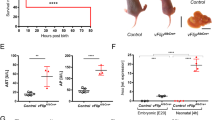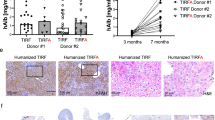Abstract
Whereas virotherapy has emerged as a novel and promising approach for neoplastic diseases, appropriate model systems have hampered preclinical evaluation of candidate conditionally replicative adenovirus agents (CRAds) with respect to liver toxicity. This is due to the inability of human viral agents to cross species. We have recently shown the human liver tissue slice model to be a facile means to validate adenoviral replication. On this basis, we sought to determine whether our ex vivo liver tissue slice model could be used to assess CRAd-mediated liver toxicity. We analyzed and compared the toxicity of a conditionally replicative adenovirus (AdΔ24) to that of a replication incompetent adenovirus (Adnull [E1−]) in mouse and human liver tissue slices. To accomplish this, we examined the hepatic apoptosis expression profile by DNA microarray analyses, and compared these results to extracellular release of aminotransferase enzymes, along with direct evidence of apoptosis by caspase-3 immunhistochemical staining and TUNEL assays. Human and mouse liver tissue slices demonstrated a marked increase in extracellular release of aminotransferase enzymes on infection with AdΔ24 compared to Adnull. AdΔ24-mediated liver toxicity was further demonstrated by apoptosis induction, as detected by caspase-3 immunohistochemical staining, TUNEL assay and microarray analysis. In conclusion, concordance of CRAd-mediated apoptosis in both the human and the mouse liver tissue slice models was demonstrated, despite the limited replication ability of CRAds in mouse liver slices. The results of this study, defining the CRAd-mediated apoptosis gene expression profiles in human and mouse liver, may lay a foundation for preclinical liver toxicity analysis of CRAd agents.
This is a preview of subscription content, access via your institution
Access options
Subscribe to this journal
Receive 12 print issues and online access
$259.00 per year
only $21.58 per issue
Buy this article
- Purchase on Springer Link
- Instant access to full article PDF
Prices may be subject to local taxes which are calculated during checkout





Similar content being viewed by others
Accession codes
Accessions
GenBank/EMBL/DDBJ
References
Nettelbeck DM, Curiel DT . Tumor-busting viruses. Sci Am 2003; 289: 68–75.
Nettelbeck DM . Virotherapeutics: conditionally replicative adenoviruses for viral oncolysis. Anticancer Drugs 2003; 14: 577–584.
Alemany R, Suzuki K, Curiel DT . Blood clearance rates of adenovirus type 5 in mice. J Gen Virol 2000; 81: 2605–2609.
Bernt KM, Ni S, Gaggar A, Li ZY, Shayakhmetov DM, Lieber A . The effect of sequestration by nontarget tissues on anti-tumor efficacy of systemically applied, conditionally replicating adenovirus vectors. Mol Ther 2003; 8: 746–755.
Zaiss AK, Liu Q, Bowen GP, Wong NC, Bartlett JS, Muruve DA . Differential activation of innate immune responses by adenovirus and adeno-associated virus vectors. J Virol 2002; 76: 4580–4590.
Lieber A, He CY, Meuse L, Schowalter D, Kirillova I, Winther B et al. The role of Kupffer cell activation and viral gene expression in early liver toxicity after infusion of recombinant adenovirus vectors. J Virol 1997; 71: 8798–8807.
Varnavski AN, Calcedo R, Bove M, Gao G, Wilson JM . Evaluation of toxicity from high-dose systemic administration of recombinant adenovirus vector in vector-naive and pre-immunized mice. Gene Ther 2005; 12: 427–436.
Malkinson AM . Molecular comparison of human and mouse pulmonary adenocarcinomas. Exp Lung Res 1998; 24: 541–555.
Duncan SJ, Gordon FC, Gregory DW, McPhie JL, Postlethwaite R, White R et al. Infection of mouse liver by human adenovirus type 5. J Gen Virol 1978; 40: 45–61.
Paielli DL, Wing MS, Rogulski KR, Gilbert JD, Kolozsvary A, Kim JH et al. Evaluation of the biodistribution, persistence, toxicity, and potential of germ-line transmission of a replication-competent human adenovirus following intraprostatic administration in the mouse. Mol Ther 2000; 1: 263–274.
Boess F, Kamber M, Romer S, Gasser R, Muller D, Albertini S et al. Gene expression in two hepatic cell lines, cultured primary hepatocytes, and liver slices compared to the in vivo liver gene expression in rats: possible implications for toxicogenomics use of in vitro systems. Toxicol Sci 2003; 73: 386–402.
Olinga P, Merema M, Slooff MJ, Meijer DK, Groothuis GM . Influence of 48 h of cold storage in University of Wisconsin organ preservation solution on metabolic capacity of rat hepatocytes. J Hepatol 1997; 27: 738–743.
Olinga P, Groen K, Hof IH, De Kanter R, Koster HJ, Leeman WR et al. Comparison of five incubation systems for rat liver slices using functional and viability parameters. J Pharmacol Toxicol Methods 1997; 38: 59–69.
Kirby TO, Rivera A, Rein D, Wang M, Ulasov I, Breidenbach M et al. A novel ex vivo model system for evaluation of conditionally replicative adenoviruses therapeutic efficacy and toxicity. Clin Cancer Res 2004; 10: 8697–8703.
Rao XM, Tseng MT, Zheng X, Dong Y, Jamshidi-Parsian A, Thompson TC et al. E1A-induced apoptosis does not prevent replication of adenoviruses with deletion of E1b in majority of infected cancer cells. Cancer Gene Ther 2004; 11: 585–593.
Duque PM, Alonso C, Sanchez-Prieto R, Lleonart M, Martinez C, de Buitrago GG et al. Adenovirus lacking the 19-kDa and 55-kDa E1B genes exerts a marked cytotoxic effect in human malignant cells. Cancer Gene Ther 1999; 6: 554–563.
Reed JC, Doctor K, Rojas A, Zapata JM, Stehlik C, Fiorentino L et al. Comparative analysis of apoptosis and inflammation genes of mice and humans. Genome Res 2003; 13: 1376–1388.
Fueyo J, Gomez-Manzano C, Alemany R, Lee PS, McDonnell TJ, Mitlianga P et al. A mutant oncolytic adenovirus targeting the Rb pathway produces anti-glioma effect in vivo. Oncogene 2000; 19: 2–12.
Heise C, Hermiston T, Johnson L, Brooks G, Sampson-Johannes A, Williams A et al. An adenovirus E1A mutant that demonstrates potent and selective systemic anti-tumoral efficacy. Nat Med 2000; 6: 1134–1139.
Krumdieck C . A new instrument for the rapid preparation of tissue slices. Anal Biochem 1980; 104: 118–123.
Rivera AA, Wang M, Suzuki K, Uil TG, Krasnykh V, Curiel DT et al. Mode of transgene expression after fusion to early or late viral genes of a conditionally replicating adenovirus via an optimized internal ribosome entry site in vitro and in vivo. Virology 2004; 320: 121–134.
Vecil GG, Lang FF . Clinical trials of adenoviruses in brain tumors: a review of Ad-p53 and oncolytic adenoviruses. J Neurooncol 2003; 65: 237–246.
Sauthoff H, Pipiya T, Heitner S, Chen S, Bleck B, Reibman J et al. Impact of E1a modifications on tumor-selective adenoviral replication and toxicity. Mol Ther 2004; 10: 749–757.
Bantel H, Schulze-Osthoff K . Apoptosis in hepatitis C virus infection. Cell Death Differ 2003; 10 (Suppl 1): S48–S58.
Bantel H, Lugering A, Heidemann J, Volkmann X, Poremba C, Strassburg CP et al. Detection of apoptotic caspase activation in sera from patients with chronic HCV infection is associated with fibrotic liver injury. Hepatology 2004; 40: 1078–1087.
McPartland JL, Guzail MA, Kendall CH, Pringle JH . Apoptosis in chronic viral hepatitis parallels histological activity: an immunohistochemical investigation using anti-activated caspase-3 and M30 cytodeath antibody. Int J Exp Pathol 2005; 86: 19–24.
Papakyriakou P, Tzardi M, Valatas V, Kanavaros P, Karydi E, Notas G et al. Apoptosis and apoptosis related proteins in chronic viral liver disease. Apoptosis 2002; 7: 133–141.
Rodrigues CM, Brites D, Serejo F, Costa A, Ramalho F, De Moura MC . Apoptotic cell death does not parallel other indicators of liver damage in chronic hepatitis C patients. J Viral Hepat 2000; 7: 175–183.
Green DR, Reed JC . Mitochondria and apoptosis. Science 1998; 281: 1309–1312.
Kroemer G, Reed JC . Mitochondrial control of cell death. Nat Med 2000; 6: 513–519.
Trent C, Tsuing N, Horvitz HR . Egg-laying defective mutants of the nematode Caenorhabditis elegans. Genetics 1983; 104: 619–647.
Forch P, Valcarcel J . Molecular mechanisms of gene expression regulation by the apoptosis-promoting protein TIA-1. Apoptosis 2001; 6: 463–468.
Yoo J, Ghiassi M, Jirmanova L, Balliet AG, Hoffman B, Fornace Jr AJ et al. Transforming growth factor-beta-induced apoptosis is mediated by Smad-dependent expression of GADD45b through p38 activation. J Biol Chem 2003; 278: 43001–43007.
Balague C, Noya F, Alemany R, Chow LT, Curiel DT . Human papillomavirus E6E7-mediated adenovirus cell killing: selectivity of mutant adenovirus replication in organotypic cultures of human keratinocytes. J Virol 2001; 75: 7602–7611.
Howe JA, Mymryk JS, Egan C, Branton PE, Bayley ST . Retinoblastoma growth suppressor and a 300-kDa protein appear to regulate cellular DNA synthesis. Proc Natl Acad Sci USA 1990; 87: 5883–5887.
Wang HG, Rikitake Y, Carter MC, Yaciuk P, Abraham SE, Zerler B et al. Identification of specific adenovirus E1A N-terminal residues critical to the binding of cellular proteins and to the control of cell growth. J Virol 1993; 67: 476–488.
Shayakhmetov DM, Li ZY, Ni S, Lieber A . Analysis of adenovirus sequestration in the liver, transduction of hepatic cells, and innate toxicity after injection of fiber-modified vectors. J Virol 2004; 78: 5368–5381.
Wang WH, Wang HL . Fulminant adenovirus hepatitis following bone marrow transplantation. A case report and brief review of the literature. Arch Pathol Lab Med 2003; 127: e246–248.
Toth K, Spencer JF, Tollefson AE, Kuppuswamy M, Doronin K, Lichtenstein DL et al. Cotton rat tumor model for the evaluation of oncolytic adenoviruses. Hum Gene Ther 2005; 16: 139–146.
Rojas-Martinez A, Wyde PR, Montgomery CA, Chen SH, Woo SL, Aguilar-Cordova E . Distribution, persistency, toxicity, and lack of replication of an E1A-deficient adenoviral vector after intracardiac delivery in the cotton rat. Cancer Gene Ther 1998; 5: 365–370.
Ginsberg HS, Lundholm-Beauchamp U, Horswood RL, Pernis B, Wold WS, Chanock RM et al. Role of early region 3 (E3) in pathogenesis of adenovirus disease. Proc Natl Acad Sci USA 1989; 86: 3823–3827.
Pacini DL, Dubovi EJ, Clyde Jr WA . A new animal model for human respiratory tract disease due to adenovirus. J Infect Dis 1984; 150: 92–97.
Acknowledgements
This work was supported by Grant of the Deutsche Forschungsgemeinschaft Sto 647/1-1 (to MA Stoff-Khalili), NIH Grant R01-DK063615 (to M Yamamoto), NIH Grant RO1CA93796 (to GP Siegal), NIH Grants RO1-CA083821, RO1-CA94084, RO1-CA93796 and Mesothelioma grant (to DT Curiel). We thank Minghui Wang and Cecil R Stockard for invaluable technical assistance.
Author information
Authors and Affiliations
Corresponding author
Rights and permissions
About this article
Cite this article
Stoff-Khalili, M., Rivera, A., Le, L. et al. Employment of liver tissue slice analysis to assay hepatotoxicity linked to replicative and nonreplicative adenoviral agents. Cancer Gene Ther 13, 606–618 (2006). https://doi.org/10.1038/sj.cgt.7700934
Received:
Revised:
Accepted:
Published:
Issue Date:
DOI: https://doi.org/10.1038/sj.cgt.7700934
Keywords
This article is cited by
-
A Tumor-stroma Targeted Oncolytic Adenovirus Replicated in Human Ovary Cancer Samples and Inhibited Growth of Disseminated Solid Tumors in Mice
Molecular Therapy (2012)
-
Reduction of nontarget infection and systemic toxicity by targeted delivery of conditionally replicating viruses transported in mesenchymal stem cells
Cancer Gene Therapy (2010)
-
Improved reproducibility in preparing precision-cut liver tissue slices
Cytotechnology (2009)
-
Cancer-specific targeting of a conditionally replicative adenovirus using mRNA translational control
Breast Cancer Research and Treatment (2008)
-
Oncolytic Adenoviruses Kill Breast Cancer Initiating CD44+CD24–/Low Cells
Molecular Therapy (2007)



